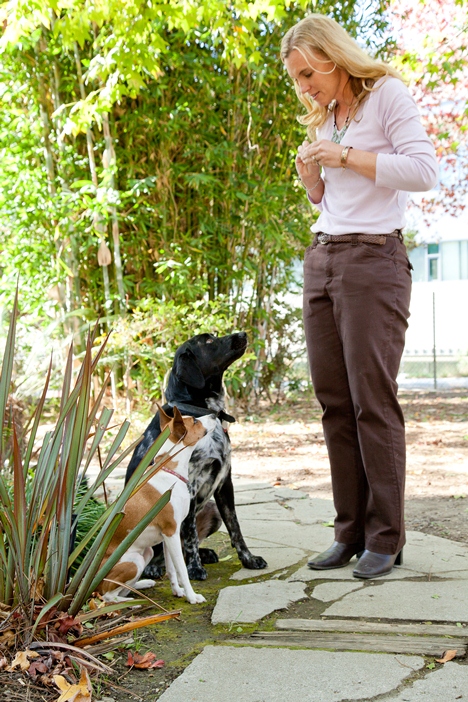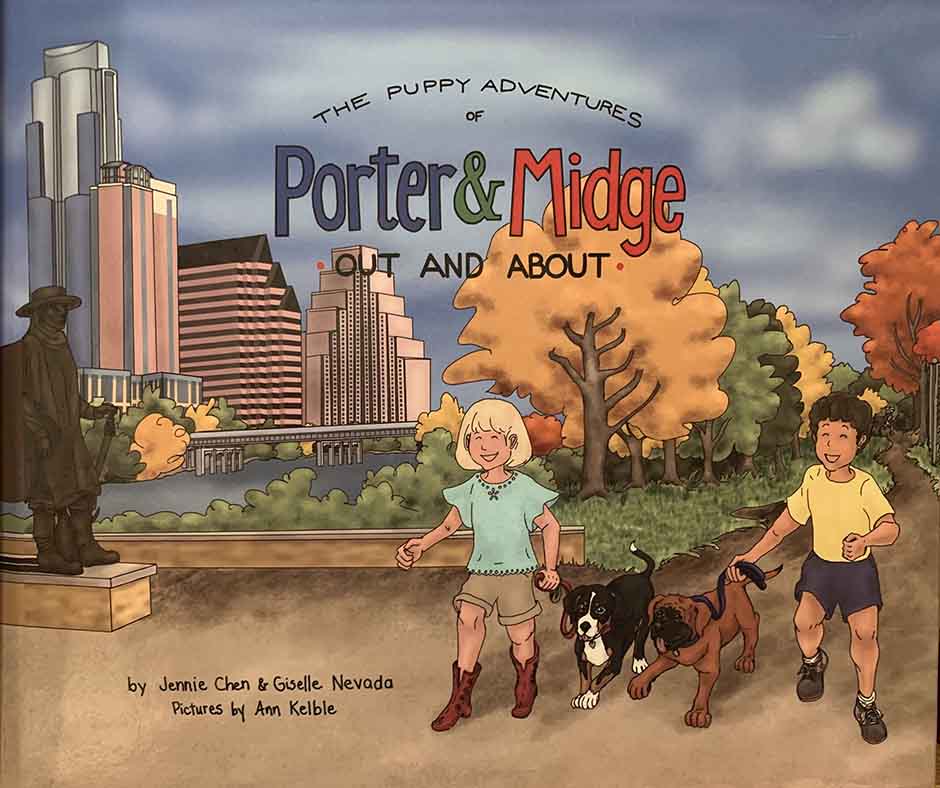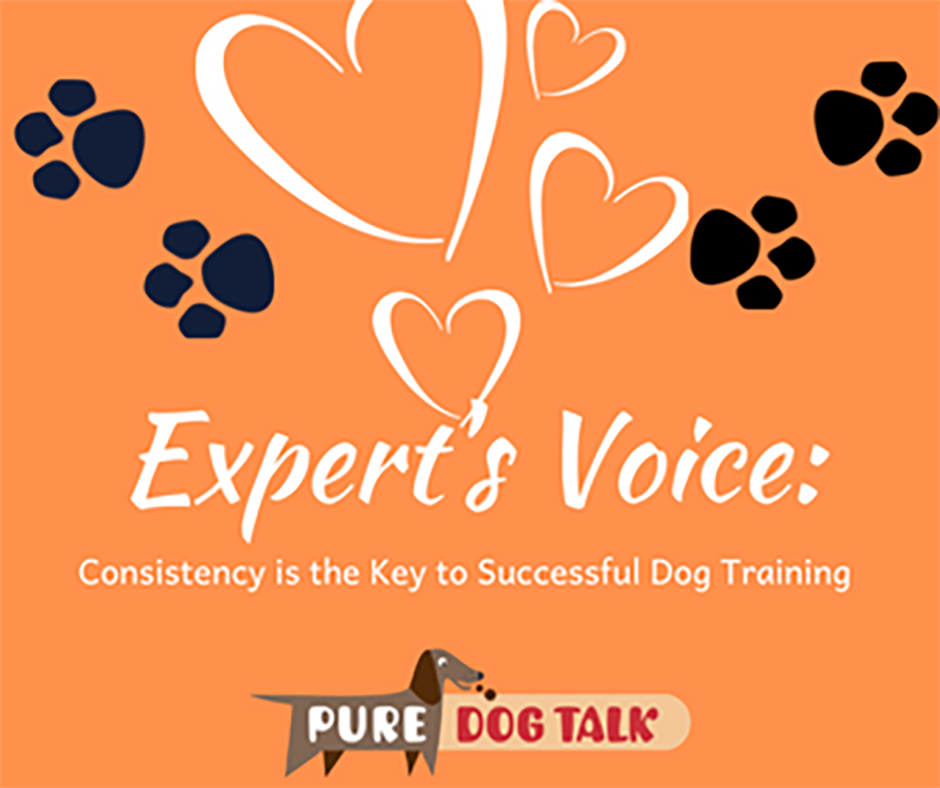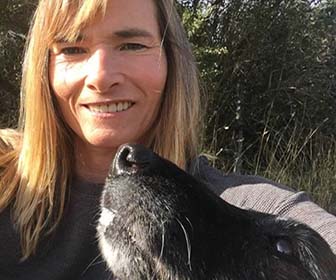583 – Book Teaches Children How to Train and Socialize a Puppy
Book Teaches Children How to Train and Socialize a Puppy

Authors Giselle Nevada and Jennie Chen join host Laura Reeves to share the story of their new book, “The Puppy Adventures of Porter and Midge – Out and About,” a book about two puppies who go on adventures, written by dog people to share with the general public.
“As dog people, these dogs are our lives,” Chen said. “Our entire lives revolve around them. So our way of communication is certainly at a different level because we’ve got the depth of knowledge that the general public doesn’t necessarily have. They might have a couple of pets throughout their lifetimes, where we’ve got dogs that we train, show, live with us, live with somebody else, and those sorts of things.
“So being able to communicate to someone who can only take a tiny snippet of what we understand in the dog world is so difficult. And then trying to translate that to a child who may not have all of the communication skills and mobility skills. How do we communicate these ideas to kids, to this different audience, so that as they grow, these are the things that are really important? What does a puppy see when they’re out in public? So yeah, we’re very passionate about this.”
The dog “characters” in the book are a Mastiff and a Greater Swiss Mountain Dog, the breeds Nevada and Chen own. The two friends met while living in Austin, TX, and developed this project from their combined passions.
“You will see a lot of people who are in the dog world also drawn in,” Chen added. “They may not be the characters, but they may be the people you know walking around on the street, the veterinarian, other people, and other dogs that you may already know from the show world. So we try to incorporate a lot of that. We also want to incorporate a lot of the breeds that aren’t as well known, like we have a Bouvier in there.
“We really wanted to speak to a different audience. Because it’s not just, ‘Oh, this is what I’m to do with an adult.’ This is what we need to do as a puppy. And now you layer on a kid, How do you get a kid to understand that? Because they don’t understand the same things we understand. They’re not able to pick up the visual cues, the body language that dogs have. How do we introduce them to this idea of socialization?”
Listen to the entire episode for more details or watch on YouTube.
546 – Consistency is the Key to Successful Dog Training
Consistency is the Key to Successful Dog Training
Trainer and author Shannon Riley-Coyner joins host Laura Reeves to talk about the key to successful dog training – consistency.
 “Really, consistency is something that even as humans, we thrive on,” Riley-Coyner said. “Like if we have a relationship, whether it’s with our children, our spouse, our friends. Inconsistency really creates fear. It creates anxiety. It creates a lack of trust.”
“Really, consistency is something that even as humans, we thrive on,” Riley-Coyner said. “Like if we have a relationship, whether it’s with our children, our spouse, our friends. Inconsistency really creates fear. It creates anxiety. It creates a lack of trust.”
Five Ways to be Consistent
- Be clear about what you are expecting. Does down mean get off or lie down?
- Make a doggy dictionary. What is the word for each behavior?
- Be clear about reinforcement. Clicker? Food? Verbal? Be consistent with the reinforcer!
- Nail your timing. “A punishment that happens 3 seconds after a behavior can be very stressful for a dog. A reinforcement like treat that’s given three seconds after the behavior, it will be confusing. But it won’t be necessarily be stressful.”
- Consistent technique. “Inconsistency is very stressful for a lot of dogs. That’s why it’s so important to have that timing and your techniques be consistent.”
Clarity is kindness
“We need a way of communicating with (our dogs),” Riley-Coyner said. “If I don’t have some consistent words that mean something, we’re going to have a hard time communicating because dogs don’t talk in language like this. They talk with body language and we need to know about these things.”
Consistency for the dogs within the family is critical, Riley-Coyner said. Which is why using consistent words, rules and a similar tone should be part of the family meeting for any new dog.
“Tone will amp up a dog or bring a dog down,” Riley-Coyner said. “It’s a lot of training ourselves.” Consistency from the beginning and building a foundation, she added, enables us as trainers to show our dogs that “clarity is kindness.”
508 – Breeding, Training and Socializing Decisions for High Drive Dogs
Breeding, Training and Socializing Decisions for High Drive Dogs
Denise Fenzi and host Laura Reeves take a deep dive into the breeding, training and socializing decisions we make with high drive dogs. Are we removing “hard” dogs from our gene pool in favor of “twitchy,” flashy high arousal dogs?
“So, drive always requires arousal,” Fenzi noted. “Arousal does not require drive. That is a good base. I like to recognize that and to recognize that arousal can hinder the dog’s ability to see the world clearly, so your socialization goes to hell, as the dog is so busy moving, they’re not actually taking it in.
“Then, when they’re three, they take it in and that’s a problem. ‘Cause for the first time they just saw a garbage can on wheels. It’s been there the whole time, they just never slowed down enough to see it. In training, we actually perpetuate that. What we do with these high arousal dogs is we work them. We get the toys and play, we focus on really early and they go for it, because they’re high arousal dogs, they need something to attach it to and so we actually undermine our socialization.”
This in-depth, experience-based discussion between industry leaders asks important questions and offers insight for breeders who want to learn more about breeding high drive dogs in any performance venue.
Laura Reeves: “I think it’s so important, when we talk about these things from the perspective of purebred dogs and doing events and doing sports and doing show, if that’s part of our consideration, all of those things it all is breed specific.”
Denise Fenzi: Absolutely
Laura Reeves: Starting at that instinct piece that you were talking about, the instinct has to be there and then you layer on all the rest of it.
Denise Fenzi: Yes. And then you’ve got your focus and all kinds of other things that are going to come into play. Even the definition. How do you define drive? My definition is “stays in the game under adversity.” So, it doesn’t matter what your game is and it doesn’t matter what the adversity is. It could be weather, could be bad training. There are dogs who are out there in crappy weather, under crappy training and I mean I don’t know how they do it, but they figure out what the trainer wants and they just flat on go forward. To me that’s drive … with a good dose of hardness
Defining and understanding drive, considering the inheritance patterns of drive and arousal, addressing anxiety as a corollary, Denise and Laura dig in to the hard topics, the difficult conversations and the implications of our breeding decisions.
Listen to part one here.
507 — Denise Fenzi on “Drive” vs “Arousal” in Dogs
Denise Fenzi on “Drive” vs “Arousal” in Dogs
Denise Fenzi, Founder of the famous Fenzi Dog Sport Academy, joins host Laura Reeves for Part 1 of this powerful and thoughtful conversation about what drives our dogs to the behaviors we see.
Denise and Laura discuss the difference between drive and arousal, and how that impacts on our dogs, particularly performance dogs, and some of the things that we as breeders need to consider when making breeding decisions.
“In the make-up of the dog, you’ve got the very bottom level,” Fenzi said. “Let’s call that instinct. Those are things that the dog does to stay alive. If you have a highly predatory dog and a rabbit goes by, the dog doesn’t think about what it’s going to do it goes. That’s the very bottom basic level. I will tell you that, in my opinion, this is where drives are rooted. So, the very bottom level is instinct in my opinion it is the hardest to change.
“Instinctually driven behaviors are very resistant to change. This is both good and bad because this is why your hunting dog goes out for an hour and does the thing. It’s painful, it’s hot, it’s tired, it’s cranky and it just keeps doing it and maybe it doesn’t even know why it keeps doing it, it just does the thing.
“One level up is the emotional level. That is where you have fear. Anxiety is linked to fear, it’s irrational fear, like you don’t even know why you’re afraid you’re just feeling anxious. You have happiness, you have anger, you have joy, you have caretaking for your young. So let’s call that the emotional level. Arousal can come from either one of those places… the bottom level the predatory drive instinctual base level, or it can come from the emotional level.
“Drive has a focus. Arousal is scattered movement. Focus sort of ties it altogether. If you have drive for a thing then you have to have focus or you just went out of drive. Now you’re looking at something else. Arousal gets complicated, because arousal can look like drive. (But) a dog can be in arousal and have no drive whatsoever.”
Listen to the whole show above to hear more.
Fenzi has titled dogs in obedience (AKC and UKC), tracking (AKC and schutzhund), schutzhund (USA), mondioring (MRSA), herding (AKC), conformation (AKC), and agility (AKC). She has two AKC obedience champions, perfect scores in both schutzhund and Mondio ringsport obedience, and is well known for her flashy and precise obedience work.
While a successful competitor, Fenzi’s real passion lies in training dogs and solving the problems that her own dogs and her students’ dogs present. She is a recognized expert in developing drive, motivation, and focus in competition dogs, and is known internationally as an engaging speaker and an expert in no-force training for sport dogs. She has consistently demonstrated the ability to train and compete with dogs using motivational methods in sports where compulsion is the norm.
504 – Dog Trainers and Dog Breeders Working Together
Dog Trainers and Dog Breeders Working Together

Kayley Paylor and her Azawakh.
Kayley Paylor, like many professional dog trainers, started in her profession after acquiring a rescue dog that had issues. She became a huge advocate for the predictability and reliability of well-bred purebred dogs as a result. Paylor joins host Laura Reeves to tackle the “elephant in the room” when it comes to dog breeders and dog trainers working together.
“It’s one of those issues where you don’t even realize that that type of (animal rights) agenda is sneaking in because the line between animal welfare and animal rights activists is a tough one,” Paylor said. “People who love their dogs and want the best for their dogs and trainers who want the best for dogs, it’s really easy to lose track of what is actually best for them in the long term. Are we going to let them suffer with mental issues when we could just clarify the issue immediately with a consequence once that is appropriate.
“So, what I tend to see and what I ran into is, again, really well-intentioned individuals who get a rescue as their first dog. Mine had health problems, as is unfortunately common, and I didn’t know that going into it. Epilepsy, dental issues, that type of thing. And some behavioral issues that come with, certainly, genetic temperament issues, but also just they didn’t have a breeder that cared about the puppy, that gave them the solid foundation.
“I dug into the behavioral issues and what I started to see, when I went through my apprenticeship, … I saw all of these incredible women who had these purebred dogs that were predictable. That you could understand exactly what was going to happen. And so I started to understand ‘oh, OK, you understand exactly what you’re going to get when you get that dog.’ I was lucky and I wasn’t the only one. All of my colleagues that came in at the same time as I did all came from a rescue background.
“All of my colleagues went that way, where we started with rescues and ended up with purebred dogs. Because if you rescue dogs, you have to understand you’re not getting anything predictable. You don’t know the background.
“From a breeder perspective, I do wish that breeders had a little bit more trust in trainers … but it’s just a breakdown in communication. Neither of them see all the good that the other one can do because of the bad in both communities.
“It’s just about getting those well-bred dogs in front of trainers. Even if you know what you’re doing. Even if you think you know what you’re doing, taking them to a puppy group class for puppy play.
“On both sides of the issue let’s just say R+ versus a balanced perspective, you’re going to get people who understand dogs and their different needs and their different drives, and you’re going to get people who don’t.”
Listen to the entire episode above and hear Paylor’s insights on finding a good fit for a trainer to work with, training insights and so much more.





